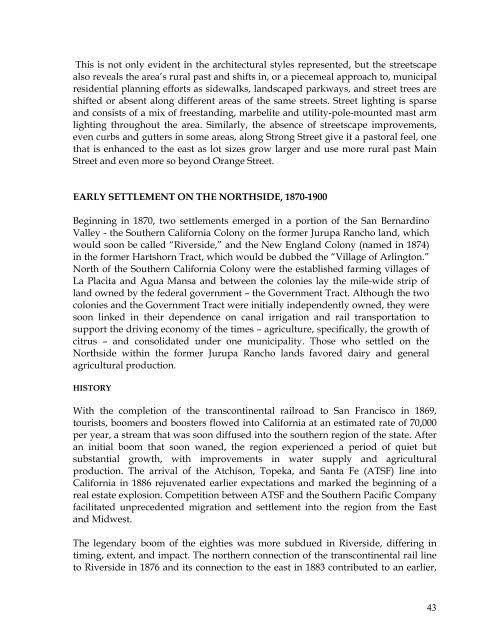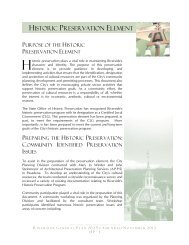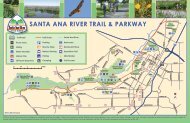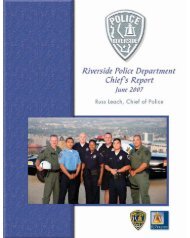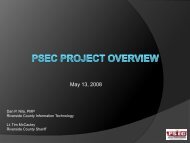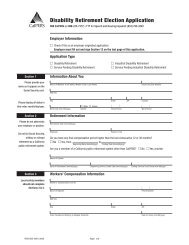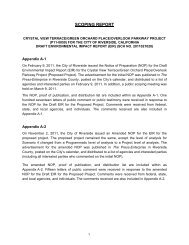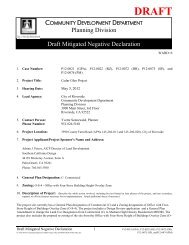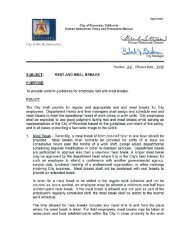Northside - City of Riverside
Northside - City of Riverside
Northside - City of Riverside
You also want an ePaper? Increase the reach of your titles
YUMPU automatically turns print PDFs into web optimized ePapers that Google loves.
This is not only evident in the architectural styles represented, but the streetscape<br />
also reveals the area’s rural past and shifts in, or a piecemeal approach to, municipal<br />
residential planning efforts as sidewalks, landscaped parkways, and street trees are<br />
shifted or absent along different areas <strong>of</strong> the same streets. Street lighting is sparse<br />
and consists <strong>of</strong> a mix <strong>of</strong> freestanding, marbelite and utility-pole-mounted mast arm<br />
lighting throughout the area. Similarly, the absence <strong>of</strong> streetscape improvements,<br />
even curbs and gutters in some areas, along Strong Street give it a pastoral feel, one<br />
that is enhanced to the east as lot sizes grow larger and use more rural past Main<br />
Street and even more so beyond Orange Street.<br />
EARLY SETTLEMENT ON THE NORTHSIDE, 1870-1900<br />
Beginning in 1870, two settlements emerged in a portion <strong>of</strong> the San Bernardino<br />
Valley - the Southern California Colony on the former Jurupa Rancho land, which<br />
would soon be called “<strong>Riverside</strong>,” and the New England Colony (named in 1874)<br />
in the former Hartshorn Tract, which would be dubbed the “Village <strong>of</strong> Arlington.”<br />
North <strong>of</strong> the Southern California Colony were the established farming villages <strong>of</strong><br />
La Placita and Agua Mansa and between the colonies lay the mile-wide strip <strong>of</strong><br />
land owned by the federal government – the Government Tract. Although the two<br />
colonies and the Government Tract were initially independently owned, they were<br />
soon linked in their dependence on canal irrigation and rail transportation to<br />
support the driving economy <strong>of</strong> the times – agriculture, specifically, the growth <strong>of</strong><br />
citrus – and consolidated under one municipality. Those who settled on the<br />
<strong>Northside</strong> within the former Jurupa Rancho lands favored dairy and general<br />
agricultural production.<br />
HISTORY<br />
With the completion <strong>of</strong> the transcontinental railroad to San Francisco in 1869,<br />
tourists, boomers and boosters flowed into California at an estimated rate <strong>of</strong> 70,000<br />
per year, a stream that was soon diffused into the southern region <strong>of</strong> the state. After<br />
an initial boom that soon waned, the region experienced a period <strong>of</strong> quiet but<br />
substantial growth, with improvements in water supply and agricultural<br />
production. The arrival <strong>of</strong> the Atchison, Topeka, and Santa Fe (ATSF) line into<br />
California in 1886 rejuvenated earlier expectations and marked the beginning <strong>of</strong> a<br />
real estate explosion. Competition between ATSF and the Southern Pacific Company<br />
facilitated unprecedented migration and settlement into the region from the East<br />
and Midwest.<br />
The legendary boom <strong>of</strong> the eighties was more subdued in <strong>Riverside</strong>, differing in<br />
timing, extent, and impact. The northern connection <strong>of</strong> the transcontinental rail line<br />
to <strong>Riverside</strong> in 1876 and its connection to the east in 1883 contributed to an earlier,<br />
43


